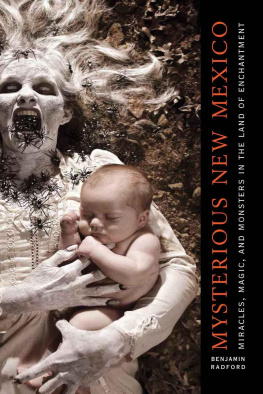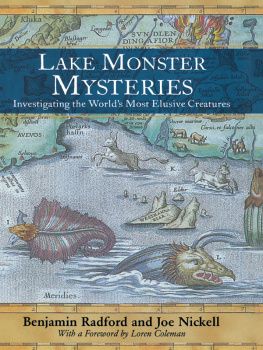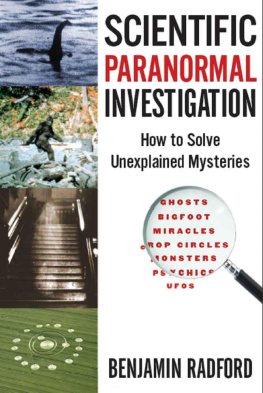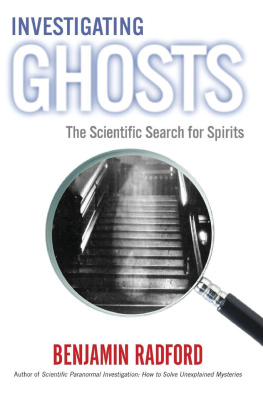Warning! Dont read this book if you have an open mind. Ben Radford goes beyond its a mangy coydog to explore an entirely new theory about the origins of the chupacabra phenomenon. My cryptozoological colleagues and fans, as well as the media, should read this one! I think Radford might be on to something! A fantastic read.
Loren Coleman , International Cryptozoology Museum, author of Bigfoot!, Cryptozoology A to Z , and other books
An amazingly thorough book .... Having sequenced the DNA of three of the purported chupacabra beasts myself, I am impressed at the depth to which Radford delves into the backstory behind the chupacabra. Unlike the numerous uncritical popular writings about the chupacabra, Radford provides easy-to-read yet scholarly coverage of this subject.
Todd R. Disotell , New York University
Tracking the Chupacabra combines detective work, scientific analysis, and a keen sense of human psychology to unravel the mystery of the chupacabra. Radford provides the cultural context for the monster, and offers a comprehensive look at both the mythological and biological elements underlying the mystery. Ben Radford is at once sympathetic to and critical of the field of cryptozoology, and the fields practitioners would do well to follow his example of measured skepticism and commitment to science and reason. This is an engaging read that both scientists and the lay public will enjoy. Radford has slain the beast!
David Daegling , University of Florida, author of Bigfoot Exposed
A wonderful adventure into the quirky legend of our newest popular monster. Radford manages a very rare feat of balancing the excitement and magic of the monster hunt, with the rational skeptical approach of the scientist. I really enjoyed it.
Stephen Asma , Columbia College, Chicago, author of On Monsters
Radford does a masterful job part detective investigation, part anthropological analysisof revealing the not-so-awful truth behind the chupacabra legend. In fact, Radfords deconstruction definitively and entertainingly sucks the mystery out of the poor old goatsucker.
Denneth Feder , Central Connecticut University, author of Frauds, Myths, and Mysteries: Science and Pseudoscience in Archaeology and other books
The most comprehensive dissection of the chupacabra phenomenon that I have ever read. Ben Radford leaves no stone unturned in his tenacious, unrelenting pursuit of precisely what isand, more to the point, what is not behind this veritable celebrity of modern-day cryptozoology. Is the chupacabra a bona fide mystery beast, or is it just a media-hyped monster of the imagination? Read this compelling book, which combines healthy skepticism with objective investigation throughout, and judge for yourself!
Karl Shuker , author of The Beasts That Hide from Man , Extraordinary Animals Worldwide , and other books
Radford goes after the chupacabra with the same kind of knowledge and energy that Dr. Van Helsing showed in pursuing Dracula in Bram Stokers classic horror novel. Radford drives a metaphorical stake into the heart of the beast, reporting his investigations in lively prose, free of academic jargon yet rich with insights from folkloristics, biology, and psychology. Radford interviewed the eyewitnesses as well as reviewing the published and popular-culture descriptions of the chupacabra; then he applied scientific and folkloric analysis to the data. His conclusionsclearly and even humorously reportedprovide the definitive word on this twenty-first-century vampire.
Jan Harold Brunvand , University of Utah, author of The Encyclopedia of Urban Legends , The Truth Never Stands in the Way of a Good Story , and many other books
Tracking
the
Chupacabra
The Vampire Beast in Fact, Fiction, and Folklore
Benjamin Radford
University of New Mexico Press, Albuquerque
ISBN for this digital edition: 978-0-8263-5016-9
2011 by Benjamin Radford
All rights reserved. Published 2011
Library of Congress Cataloging-in-Publication Cata
Radford, Benjamin, 1970
Tracking the Chupacabra : the vampire beast in fact, fiction, and folklore / Benjamin Radford.
p. cm.
Includes index.
ISBN 978-0-8263-5015-2 (pbk. : alk. paper)
1. Chupacabras. I. Title.
QL89.2.C57R34 2011
001.944dc22
2010041879
This book is dedicated to those for whom truth matters.
Acknowledgments
I would like to thank the following people for their support, ideas, and research assistance in slaying this vampire: Maya Elsner, Tom Flynn, Jenna Griffith, Jay Koester, Daniel Loxton, Blake Smith, David Sutton, and Jill Root. And, of course, The Mom and The Dad.
Thanks also to all the librarians, experts, and chupacabra eyewitnesses who shared their stories with me, including Jerry Ayer, Phylis Canion, and Madelyne Tolentino.
1: The Goatsucker Mystery
A mong the monsters said to roam the worlds desolate deserts and dense jungles, perhaps none is more feared than the bloodthirsty chupacabra. Rooted in conspiracy theory and anti-American sentiment, the chupacabra is a contradictory and bizarre amalgamation of vampiric monster, folk myth, and chameleon. It is a shapeshifter, changing its appearance and characteristics according to the time and place it is seen, and according to the beliefs and expectations of those who see it.
Bigfoot, the mysterious bipedal beast said to roam the North American wilderness, is named after what it leaves behind: big footprints. Bigfoots Hispanic cousin, the chupacabra, is also known less for what it is than for what it leaves behind: dead animals. Though goats are said to be its favorite prey ( chupacabra means goat sucker in Spanish), it has also been blamed for attacks on cats, sheep, rabbits, dogs, chickens, ducks, hogs, and other animals.
Descriptions of the chupacabra vary widely, but many accounts suggest that the creature stands about four to five feet tall. It has short but powerful legs that allow it to leap fantastic distances, long claws, and terrifying black or glowing red eyes. Some claim it has spikes down its back; others report seeing stubby, bat-like wings. Some say the stench of sulfur taints the air around chupacabras, or that it emits a terrifying hiss when threatened (see, for example, Carroll 2003).
While some mistakenly believe that chupacabra sightings date back to the 1970s, the chupacabra first gained real notoriety in 1995 in Puerto Rico. No one knew for certain why or how the chupacabra seemingly suddenly sprang into existence, but many Latin Americans believe it is the unholy creation of secret U.S. government experiments in the jungles of Puerto Rico. It had a heyday of about five years, when it was widely reported in Mexico, Chile, Nicaragua, Spain, Argentina, Brazil, and Florida, among other places.














